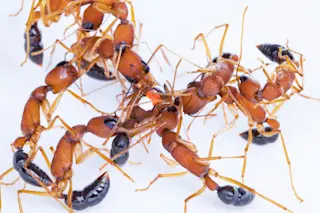Indian jumping ants form a "police ball" around a feisty subordinate (somewhere in the middle). (Credit: Clint Penick) A months-long Indian jumping ant Battle Royale is almost as brutal as the process to elect members of Congress. But after the dust settles in the ant colony and on the campaign trail, the hierarchies that emerge are, in a loose sense, similar. When an Indian jumping ant (Harpegnathos saltator) colony’s queen dies, her distinctive I’m-having-babies pheromones stop circulating, and workers, alerted by the absence of her familiar scent, gather at the center of the colony and form a circle around the larvae and pupae. A single ant starts beating another ant’s head with its antennae, and in no time half the ants in the colony are engaged in antennal fencing duels. Slaps escalate to head biting, and “police” ultimately intervene and restore order — more on that later. The ants, of ...
Inside an Ant Royal Rumble
Discover how Indian jumping ants establish a shared dominance hierarchy through unique behaviors and combat strategies.
More on Discover
Stay Curious
SubscribeTo The Magazine
Save up to 40% off the cover price when you subscribe to Discover magazine.
Subscribe













